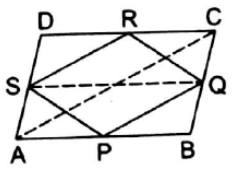P.Q.R.S are respectively the midpoints of the sides AB, BC, CD and DA of ‖ gm ABCD. Show that PQRS is a parallelogram and also show that
Ar(‖gm PQRS) = ![]() x ar(‖gm ABCD).
x ar(‖gm ABCD).


Given : ABCD is a parallelogram and P,Q,R,S are the midpoints of AB,BC,CD,AD respectively
To prove: (i) PQRS is a parallelogram
(ii) Area(‖gm PQRS) = ![]() x area(‖gm ABCD)
x area(‖gm ABCD)
Construction : Join AC ,BD,SQ
Proof:
(i)
As S and R are midpoints of AD and CD respectively, in ∆ACD
SR || AC [By midpoint theorem] ------------------- (1)
Similarly in ∆ABC , P and Q are midpoints of AB and BC respectively
PQ || AC [By midpoint theorem] ------------------ (2)
From (1) and (2)
SR || AC || PQ
![]() SR || PQ ------------------- (3)
SR || PQ ------------------- (3)
Again in ∆ACD as S and P are midpoints of AD and CB respectively
SP || BD [By midpoint theorem] ------------------ (4)
Similarly in ∆ABC , R and Q are midpoints of CD and BC respectively
RQ || BD [By midpoint theorem] -------------------- (5)
From (4) and (5)
SP || BD || RQ
![]() SP || RQ ----------- (6)
SP || RQ ----------- (6)
From (3) and (6)
We can say that opposite sides are Parallel in PQRS
Hence we can conclude that PQRS is a parallelogram.
(ii)
Here ABCD is a parallelogram
S and Q are midpoints of AD and BC respectively
![]() SQ || AB
SQ || AB
![]() SQAB is a parallelogram
SQAB is a parallelogram
Now, area(∆SQP) = ![]() x area of (SQAB) -------------- 1
x area of (SQAB) -------------- 1
[Since ∆SQP and ||gm SQAB have same base and lie between same parallel lines]
Similarly
S and Q are midpoints of AD and BC respectively
![]() SQ || CD
SQ || CD
![]() SQCD is a parallelogram
SQCD is a parallelogram
Now, area(∆SQR) = ![]() x area of (SQCD) ------------------- 2
x area of (SQCD) ------------------- 2
[Since ∆SQR and ||gm SQCD have same base and lie between same parallel lines]
Adding (1) and (2) we get
area(∆SQP) + area(∆SQR) = ![]() x area of (SQAB) +
x area of (SQAB) + ![]() x area of (SQCD)
x area of (SQCD)
![]() area(PQRS) =
area(PQRS) = ![]() (area of (SQAB) + area of (SQCD))
(area of (SQAB) + area of (SQCD))
![]() Area(‖gm PQRS) =
Area(‖gm PQRS) = ![]() x area(‖gm ABCD)
x area(‖gm ABCD)
Hence proved